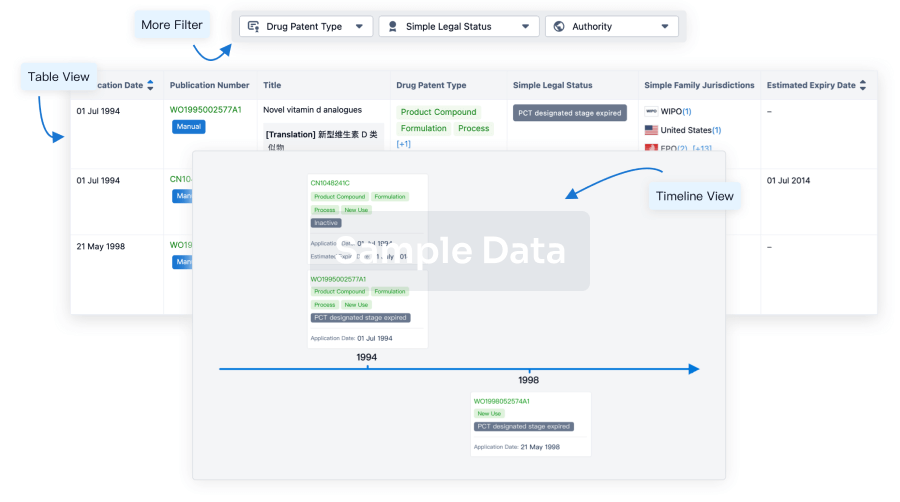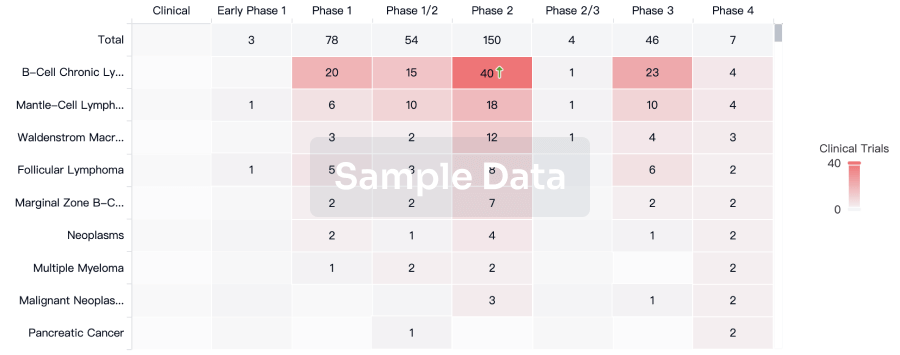Request Demo
Last update 08 May 2025
Thymulin
Last update 08 May 2025
Overview
Basic Info
Drug Type Chemical drugs |
Synonyms FTSZn, Nonathymulin, Thymalin + [1] |
Target- |
Action modulators |
Mechanism Immunomodulators |
Therapeutic Areas |
Active Indication- |
Inactive Indication |
Originator Organization |
Active Organization- |
Inactive Organization |
License Organization- |
Drug Highest PhaseDiscontinuedPreclinical |
First Approval Date- |
Regulation- |
Structure/Sequence
Molecular FormulaC33H54N12O15 |
InChIKeyLIFNDDBLJFPEAN-BPSSIEEOSA-N |
CAS Registry63958-90-7 |
Sequence Code 14866846

Related
100 Clinical Results associated with Thymulin
Login to view more data
100 Translational Medicine associated with Thymulin
Login to view more data
100 Patents (Medical) associated with Thymulin
Login to view more data
596
Literatures (Medical) associated with Thymulin01 Dec 2024·Alzheimer's & Dementia
Systemic thymulin overexpression mitigates cognitive and molecular impairments in a rat model of sporadic Alzheimer’s Disease
Article
Author: Hanotte, Juliette López ; Pardo, Joaquín ; Escobedo, Ana Abril Vidal ; Peralta, Facundo ; Reggiani, Paula Cecilia
01 Apr 2024·Polski Merkuriusz Lekarski
Expression features of T-lymphocytes, B-lymphocytes and macrophages in the post-traumatic regenerate of the mandible rats under conditions of filling a bone defect with hydroxyapatite-containing osteotropic material and thymalin injecting the surrounding soft tissues
Article
Author: Myroshnychenko, Mykhailo S ; Boiko, Andrii A ; Shapkin, Anton S ; Marakushyn, Dmytro I ; Malanchuk, Vladislav A ; Markovska, Olena V
01 Jan 2024·Wiadomości Lekarskie
Reparative osteogenesis in mandible in cases of filling a bone defect with hydroxyapatite-containing osteotropic material and injecting the surrounding soft tissues with thymalin: experimental and morphological study
Article
Author: Myroshnychenko, Mykhailo S ; Boiko, Andrii A ; Malanchuk, Vladislav A
2
News (Medical) associated with Thymulin14 Feb 2024
In a series of warning letters released this week, the FDA went after three different firms for infractions ranging from unclean manufacturing to illicit sales of semaglutide and tirzepatide.
Following an enforcement lull over the past few weeks, the U.S. FDA has unleashed a salvo of pharmaceutical warning letters targeting both manufacturing infractions and online sales of knockoff weight loss meds.
On the production front, the FDA chided Indian ophthalmology player Madhu Instruments in a letter dated Feb. 1. The FDA laid out its concerns after inspecting Madhu Instruments’ manufacturing facility in New Delhi from Oct. 11-21, 2022, which yielded a Form 483.
The FDA also placed Madhu Instruments on import alert on May 31, 2023. While the company offered a response to the FDA’s Form 483 back in November 2022, its response was subpar, according to the FDA.
Ultimately, the FDA determined that certain products manufactured at Madhu Instruments' plant are adulterated because they’ve either been prepared, packed or held under insanitary conditions. In turn, those products could be “contaminated with filth” or “rendered injurious to health,” the FDA added.
The regulator’s hygiene concerns didn’t stop there, either, with investigators slamming the ophthalmology outfit over the cleanliness of its plant writ large.
Specifically, the FDA investigators noted Madhu Instruments’ facility was in a “state of disrepair.”
Agency officials found peeling paint on the ceilings of manufacturing rooms as well as a plastic bag covering a HEPA filter in the manufacturing area, which impeded airflow. Further, investigators found broken tiles along the base of the wall in the manufacturing rooms that had “residue adhering to them.”
In turn, Madhu Instruments’ plant isn’t suitable for drug and device production, the FDA explained. The regulator also pointed to “visibly dirty” and “stained” manufacturing equipment.
Formed in 1989, Madhu Instruments says on its website that it aims to become the “undisputed leader” in its segments of the ophthalmic industry.
“Our commitment towards quality is paramount and we believe good healthcare is a right of every human being, which is why manufacturing devices that are 100% reliable through constant progressive innovation is not only our passion but a commitment towards our vision,” Madhu Instruments says online.
Also in February, the FDA dispensed warning letters to Miami’s US Chem Labs and New York City’s Synthetix. Both companies were accused of peddling unapproved versions of Novo Nordisk and Eli Lilly’s respective obesity and diabetes meds, semaglutide and tirzepatide.
Novo’s semaglutide is sold as Ozempic and Rybelsus in Type 2 diabetes and bears the name Wegovy in obesity. Lilly’s tirzepatide, for its part, is called Mounjaro in diabetes and Zepbound for weight loss.
According to the FDA, both US Chem and Synthetix listed illicit GLP-1s on their websites as “research chemicals only” and “not for human consumption” despite evidence to the contrary.
What’s more, US Chem also markets the peptide thymalin, claiming it can boost patients' immune systems and metabolisms. In its warning letter, the FDA said it was “particularly concerned” that the company was marketing this drug for use in children.
Aside from being unapproved versions of established and marketed drugs, US Chem's and Synthetix’s versions of semaglutide and tirzepatide are considered misbranded because the companies failed to include labeling with proper instructions for use, the FDA said.
With the FDA’s help, both Eli Lilly and Novo Nordisk have been going after counterfeit versions of their meds in recent months. The phenomenon of a GLP-1 black market is likely related to, at least in part, high demand and persistent shortages of both companies’ drugs.
Last week, meanwhile, Novo Nordisk reached confidential settlements with two Florida peddlers of compounded semaglutide. The settlement includes permanent injunction orders, which call on the sellers to stop using Novo trademarks and disclose for a year that compounded versions of Ozempic and Wegovy haven’t gone through the safety and efficacy standards the FDA requires for approved medications.
It's been a busy year so far for the FDA, which dispensed multiple warning letters in January. Late last month, Mexico’s Glicerinas Industriales, which supplies drug components like glycerin to pharmaceutical manufacturers, was nailed with a warning letter citing the company for product testing and documentation shortfalls.

14 Feb 2024
Synthetix and US Chem Labs have 15 days to respond to the FDA to address the concerns. Credit: Postmodern Studio via Shutterstock.
The US Food and Drug Administration (FDA) has sent warning letters to Synthetix and US Chem Labs for selling unapproved and misbranded versions of GLP-1 therapies semaglutide and tirzepatide— the active ingredients in weight loss and diabetes drugs.
Synthetix, which sells drugs on website Helix Chemical Supply, markets semaglutide and tirzepatide “for research purposes”. However, the FDA argues that evidence on its website contradicts this claim. In the warning letter from the FDA, the agency said: “Evidence obtained from your website establishes that your products are intended to be drugs for human use.” The letters were sent following a review of their websites conducted by the agency in October.
US Chem Labs also claims its semaglutide and tirzepatide is “for research purposes”. However, the products are accompanied by claims such as weight loss, reducing the risk of stroke, heart attack, or heart disease. In addition to pulling up US Chem Labs for misbranding the obesity drugs, in its warning letter, the FDA said it was “particularly concerned” that the company was selling a product called thymalin to children. Thymalin is a peptide hormone that regulates the immune system. US Chem Labs claimed it can treat immunosuppression after chemotherapy.
The companies have 15 days to notify the agency of steps to address any violations.
Novo Nordisk
’s semaglutide is marketed as Ozempic for type-2 diabetes, and Wegovy for obesity. Eli Lilly’s tirzepatide is called Mounjaro when packaged as a medication for diabetes and Zepbound for weight loss.
See Also:
US FDA accepts review of argenx’s VYVGART Hytrulo for CIDP
The high demand for anti-obesity drugs has led to an increase in counterfeit and fake versions of the drugs being sold illegally. In October 2023, the UK Medicines and Healthcare products Regulatory Agency (MHRA)
identified two wholesalers
who were falsely labelling pre-filled Ozempic pens.
Across the pond, Novo
continues legal action
against pharmacies selling knockoff Ozempic after suing a compounding pharmacy and refiling a suit against another for selling fake semaglutide in Florida, US in December 2023.
Last June, Novo filed trademark infringement lawsuits against five sellers of counterfeit versions of the drugs, including Ekzotica Corp.’s Cosmetic Laser Professionals Med Spa in Miami and Effinger Health’s Nuvida Rx Weight Loss in Tallahassee. Confidential settlements were made last week with the first two companies having resolved cases.
Both Novo and Lilly continue the crackdown on these alternate sellers of the popular drugs, however, the issue may only be exacerbated by
drug shortages
. As the demand for the drugs stays high, the problem of knockoff versions and compounding pharmacies persists.

Patent Infringement
100 Deals associated with Thymulin
Login to view more data
External Link
| KEGG | Wiki | ATC | Drug Bank |
|---|---|---|---|
| - | Thymulin | - | - |
R&D Status
10 top R&D records. to view more data
Login
| Indication | Highest Phase | Country/Location | Organization | Date |
|---|---|---|---|---|
| Rheumatoid Arthritis | Preclinical | Japan | - |
Login to view more data
Clinical Result
Clinical Result
Indication
Phase
Evaluation
View All Results
| Study | Phase | Population | Analyzed Enrollment | Group | Results | Evaluation | Publication Date |
|---|
No Data | |||||||
Login to view more data
Translational Medicine
Boost your research with our translational medicine data.
login
or

Deal
Boost your decision using our deal data.
login
or

Core Patent
Boost your research with our Core Patent data.
login
or

Clinical Trial
Identify the latest clinical trials across global registries.
login
or

Approval
Accelerate your research with the latest regulatory approval information.
login
or

Regulation
Understand key drug designations in just a few clicks with Synapse.
login
or

AI Agents Built for Biopharma Breakthroughs
Accelerate discovery. Empower decisions. Transform outcomes.
Get started for free today!
Accelerate Strategic R&D decision making with Synapse, PatSnap’s AI-powered Connected Innovation Intelligence Platform Built for Life Sciences Professionals.
Start your data trial now!
Synapse data is also accessible to external entities via APIs or data packages. Empower better decisions with the latest in pharmaceutical intelligence.
Bio
Bio Sequences Search & Analysis
Sign up for free
Chemical
Chemical Structures Search & Analysis
Sign up for free
